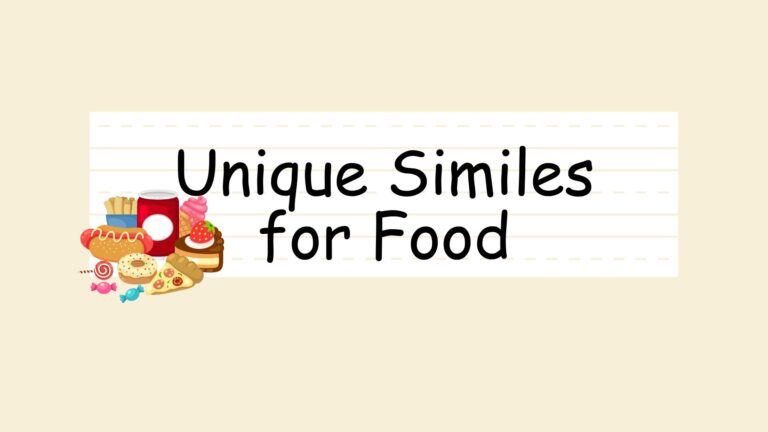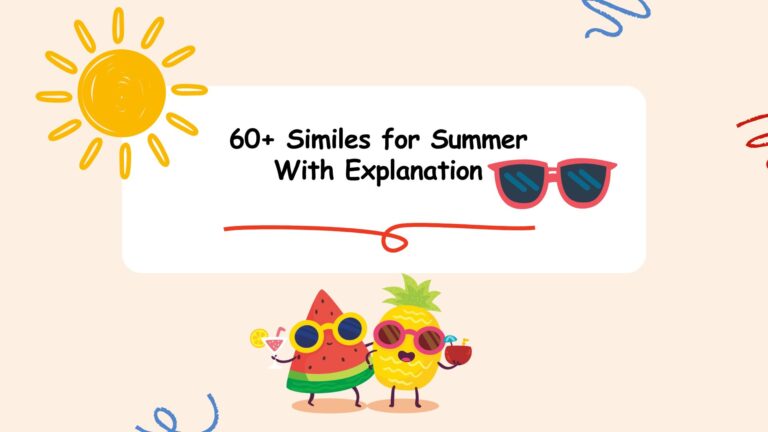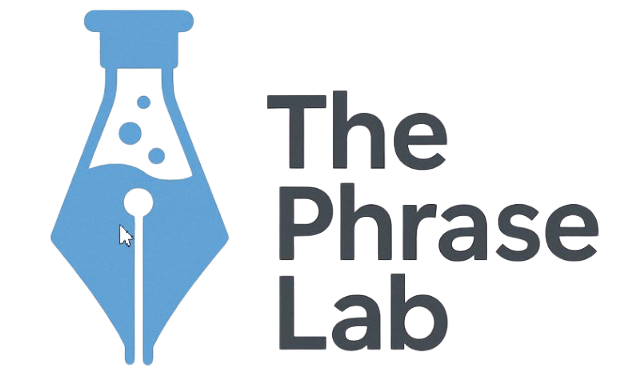
Similes for Relationships: Understanding Comparisons in Love and Life

Understanding how we describe relationships is crucial for effective communication and deeper understanding. Similes, figures of speech that compare two unlike things using “like” or “as,” offer a powerful tool for illustrating the nuances and complexities of human connections. This article explores a wide range of similes used to describe relationships, providing examples, usage rules, and practice exercises to enhance your understanding and application of this literary device. Whether you’re a student, writer, or simply someone interested in improving your communication skills, this guide will equip you with the knowledge to use similes effectively to depict relationships in vivid and meaningful ways.
Table of Contents
- Introduction
- Definition of Similes for Relationships
- Structural Breakdown of Relationship Similes
- Types of Similes in Relationships
- Examples of Relationship Similes
- Usage Rules for Relationship Similes
- Common Mistakes When Using Relationship Similes
- Practice Exercises
- Advanced Topics: Metaphors vs. Similes
- Frequently Asked Questions
- Conclusion
Definition of Similes for Relationships
A simile is a figure of speech that compares two unlike things using the words “like” or “as.” In the context of relationships, similes are used to describe the nature, quality, or dynamics between people by likening it to something else. This comparison helps to create a more vivid and relatable understanding of the relationship being described. Similes function to add depth, emotion, and imagery to our descriptions of relationships, making them more engaging and understandable. They are often used in literature, poetry, and everyday conversation to convey complex feelings and dynamics in a concise and impactful way.
The key element of a simile is the comparison between two dissimilar things. For example, saying “Their love is like a warm fire” compares the feeling of love to the warmth and comfort of a fire. This comparison helps the listener or reader understand the love as comforting, nurturing, and perhaps even passionate. Understanding the function and purpose of similes allows for more effective communication and a greater appreciation of the nuances within relationships.
Structural Breakdown of Relationship Similes
The structure of a simile is quite straightforward, typically consisting of two parts: the subject (the relationship being described) and the object (the thing it is being compared to), connected by the words “like” or “as.” Understanding this structure allows for the creation and interpretation of similes with greater accuracy and creativity.
The basic formula for a simile is: Subject + “like” or “as” + Object. Let’s break this down further:
- Subject: This is the relationship you are describing. It could be a romantic relationship, a friendship, a family bond, or any other type of connection between people.
- “Like” or “As”: These are the connecting words that signal a comparison. They indicate that the subject and object share a similar quality or characteristic.
- Object: This is the thing to which the relationship is being compared. It should be something familiar and easily understandable, allowing the audience to grasp the intended meaning of the simile.
For instance, in the simile “Their friendship is like a sturdy oak tree,” the subject is “their friendship,” the connecting word is “like,” and the object is “a sturdy oak tree.” This structure clearly conveys that the friendship is strong, reliable, and enduring, much like an oak tree.
Types of Similes in Relationships
Similes can be categorized based on the type of comparison they make, reflecting the positive, negative, or neutral aspects of the relationship. Understanding these categories can help you choose the most appropriate simile to convey your intended meaning.
Positive Relationship Similes
Positive similes highlight the beneficial and enjoyable aspects of a relationship. They emphasize qualities such as love, happiness, support, and trust. These similes often use imagery that evokes feelings of warmth, comfort, and security.
Examples of positive similes include: “Their love is like a summer breeze,” “Their friendship is as strong as steel,” and “Their bond is like a warm blanket on a cold day.” These similes evoke feelings of comfort, strength, and pleasantness, reflecting the positive nature of the relationship.
Negative Relationship Similes
Negative similes, on the other hand, describe the problematic or challenging aspects of a relationship. They may highlight qualities such as conflict, tension, distance, or distrust. The imagery used in these similes often evokes feelings of discomfort, pain, or unease.
Examples of negative similes include: “Their relationship is like a battlefield,” “Their communication is as strained as a tightrope,” and “Their connection is like a broken vase.” These similes create a sense of conflict, tension, and fragility, reflecting the negative aspects of the relationship.
Neutral Relationship Similes
Neutral similes describe relationships without explicitly conveying positive or negative connotations. They often focus on the factual or objective aspects of the relationship, such as its duration, intensity, or complexity. These similes can be used to provide a balanced or unbiased perspective.
Examples of neutral similes include: “Their relationship is like a well-worn path,” “Their interactions are as predictable as the sunrise,” and “Their connection is like a complex puzzle.” These similes provide a descriptive account of the relationship without necessarily implying positive or negative judgments.
Complex Relationship Similes
Complex similes involve more elaborate comparisons that capture multiple aspects of a relationship. These similes may combine positive and negative elements or use more abstract and nuanced imagery. They are often used to convey a deeper and more intricate understanding of the relationship.
An example of a complex simile is: “Their relationship is like a garden, requiring constant care and attention to flourish, but also capable of producing beautiful blooms.” This simile acknowledges the effort required to maintain the relationship while also highlighting its potential for growth and beauty.
Examples of Relationship Similes
To better understand how similes can be used to describe different types of relationships, let’s explore various examples categorized by relationship type.
Similes for Love
Similes for love often focus on the intensity, passion, and emotional connection between partners. They can also highlight the comfort, security, and support that love provides.
The following table provides a range of similes that can be used to describe love in different contexts. Each simile aims to capture a unique aspect of love, from its initial spark to its enduring strength.
| Simile | Meaning |
|---|---|
| Their love is like a raging fire. | Passionate and intense. |
| Their love is as gentle as a spring breeze. | Tender and comforting. |
| Their love is like a guiding star. | Providing direction and hope. |
| Their love is as deep as the ocean. | Profound and boundless. |
| Their love is like a comforting song. | Soothing and familiar. |
| Their love is as strong as a mountain. | Resilient and unwavering. |
| Their love is like a blooming flower. | Growing and beautiful. |
| Their love is as sweet as honey. | Pleasant and delightful. |
| Their love is like a warm embrace. | Comforting and secure. |
| Their love is as bright as the sun. | Radiant and joyful. |
| Their love is like a peaceful river. | Calm and serene. |
| Their love is as precious as gold. | Valuable and cherished. |
| Their love is like a protective shield. | Safeguarding and supportive. |
| Their love is as constant as the stars. | Reliable and enduring. |
| Their love is like a playful kitten. | Fun and carefree. |
| Their love is as vibrant as a rainbow. | Colorful and full of life. |
| Their love is like a sturdy bridge. | Connecting and supportive. |
| Their love is as refreshing as rain. | Renewing and revitalizing. |
| Their love is like a cozy fireplace. | Warm and inviting. |
| Their love is as clear as crystal. | Pure and transparent. |
| Their love is like a tall tree. | Grounded and strong. |
| Their love is as soft as a feather. | Gentle and delicate. |
| Their love is like a perfect painting. | Beautiful and harmonious. |
| Their love is as reliable as a compass. | Guiding and trustworthy. |
| Their love is like a flowing melody. | Harmonious and pleasant. |
| Their love is as solid as a rock. | Dependable and stable. |
| Their love is like a shared dream. | Meaningful and intimate. |
| Their love is as resilient as bamboo. | Flexible and strong. |
| Their love is like a well-tended garden. | Growing and thriving. |
| Their love is as boundless as the sky. | Limitless and free. |
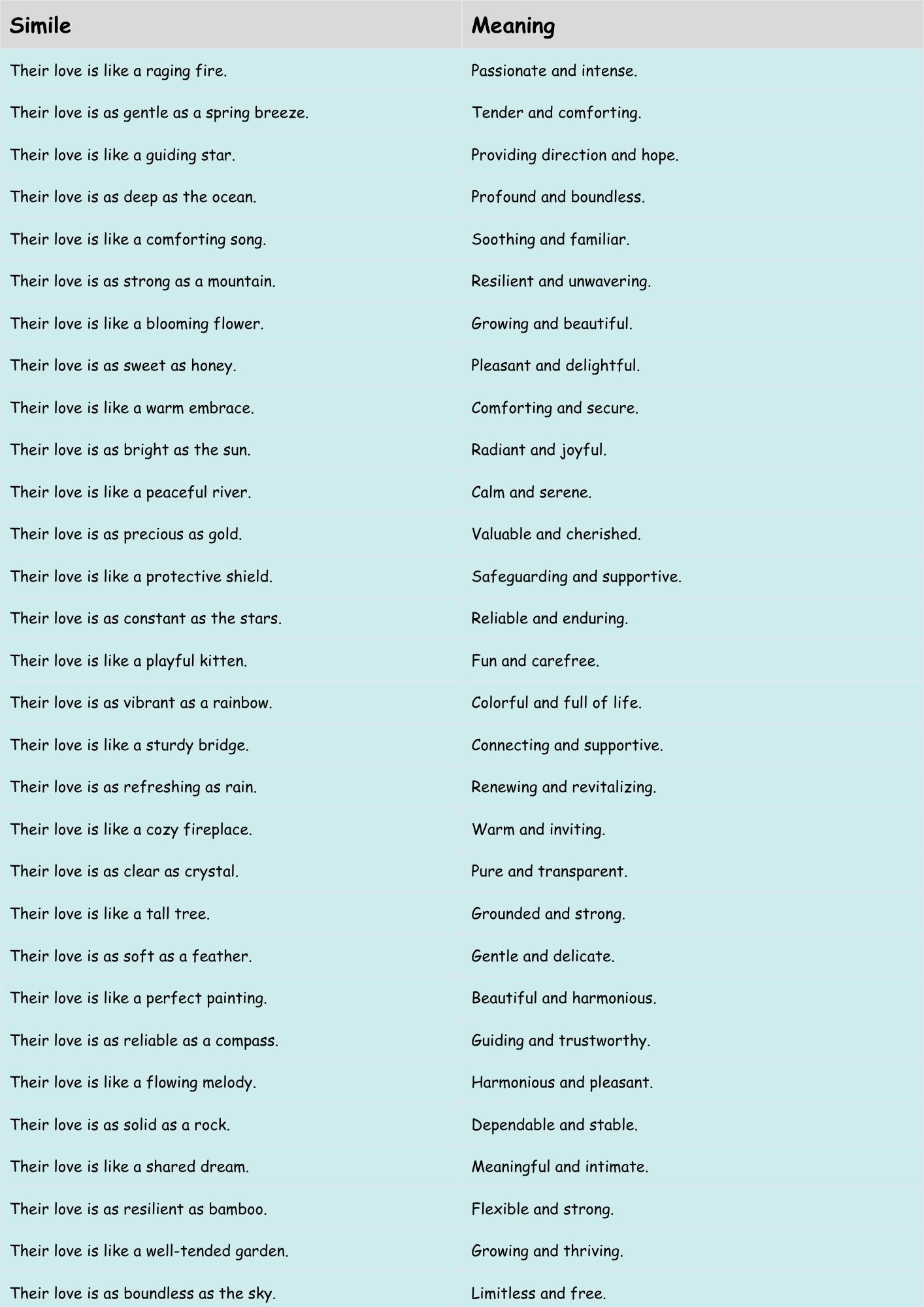
These similes can be used to add depth and emotion to your descriptions of romantic relationships, making them more engaging and relatable.
Similes for Friendship
Friendship similes often emphasize the qualities of loyalty, support, and shared experiences. They can also highlight the fun, laughter, and companionship that friends provide.
The following table presents a variety of similes that can be used to describe friendships. Each simile captures a different aspect of friendship, from its playful and lighthearted moments to its unwavering support during challenging times.
| Simile | Meaning |
|---|---|
| Their friendship is like a comfortable pair of shoes. | Familiar and easygoing. |
| Their friendship is as bright as a sunny day. | Cheerful and uplifting. |
| Their friendship is like a sturdy bridge. | Connecting and supportive. |
| Their friendship is as constant as the North Star. | Reliable and guiding. |
| Their friendship is like a shared joke. | Fun and lighthearted. |
| Their friendship is as strong as an oak tree. | Resilient and enduring. |
| Their friendship is like a secret language. | Intimate and understanding. |
| Their friendship is as precious as a rare gem. | Valuable and cherished. |
| Their friendship is like a warm cup of tea. | Comforting and soothing. |
| Their friendship is as solid as a rock. | Dependable and unwavering. |
| Their friendship is like a lively conversation. | Engaging and stimulating. |
| Their friendship is as true as gold. | Genuine and authentic. |
| Their friendship is like a shared adventure. | Exciting and memorable. |
| Their friendship is as deep as a well. | Profound and meaningful. |
| Their friendship is like a helping hand. | Supportive and caring. |
| Their friendship is as bright as a firefly. | Sparkling and joyful. |
| Their friendship is like a favorite book. | Comforting and familiar. |
| Their friendship is as loyal as a dog. | Faithful and devoted. |
| Their friendship is like a shared song. | Harmonious and enjoyable. |
| Their friendship is as refreshing as a cool drink. | Revitalizing and pleasant. |
| Their friendship is like a strong anchor. | Stable and secure. |
| Their friendship is as playful as puppies. | Fun and carefree. |
| Their friendship is like a treasure chest. | Full of memories and shared experiences. |
| Their friendship is as sturdy as a castle wall. | Protective and enduring. |
| Their friendship is like a compass. | Guiding and supportive. |
| Their friendship is as warm as sunshine. | Comforting and cheerful. |
| Their friendship is like a cozy blanket. | Comforting and safe. |
| Their friendship is as clear as water. | Transparent and honest. |
| Their friendship is like a well-worn path. | Familiar and comfortable. |
| Their friendship is as sweet as pie. | Pleasant and enjoyable. |
These similes can add depth and color to your descriptions of friendships, making them more vivid and relatable.
Similes for Family Relationships
Family relationship similes often highlight the bonds of kinship, tradition, and shared history. They can also emphasize the complexities, challenges, and unconditional love that characterize family connections.
The following table provides a diverse set of similes that can be used to describe family relationships. Each simile reflects a unique aspect of family dynamics, from the warmth and security of a close-knit family to the occasional friction and challenges that can arise.
| Simile | Meaning |
|---|---|
| Their family is like a close-knit quilt. | Warm, comforting, and interconnected. |
| Their family is as rooted as an ancient tree. | Strong, enduring, and deeply connected. |
| Their family is like a symphony orchestra. | Harmonious, complex, and collaborative. |
| Their family is as chaotic as a busy marketplace. | Lively, unpredictable, and full of activity. |
| Their family is like a well-worn photograph album. | Full of memories, stories, and shared history. |
| Their family is as supportive as a sturdy foundation. | Reliable, unwavering, and providing security. |
| Their family is like a tangled ball of yarn. | Complex, intertwined, and sometimes difficult to unravel. |
| Their family is as loving as a mother’s embrace. | Tender, nurturing, and unconditionally supportive. |
| Their family is like a patchwork of different personalities. | Diverse, unique, and complementary. |
| Their family is as resilient as bamboo in the wind. | Flexible, adaptable, and able to withstand challenges. |
| Their family is like a shared secret. | Intimate, understanding, and bound by common experiences. |
| Their family is as comforting as a home-cooked meal. | Nourishing, familiar, and providing a sense of belonging. |
| Their family is like a collection of antique furniture. | Valuable, cherished, and representing a rich heritage. |
| Their family is as steadfast as a lighthouse in a storm. | Guiding, protective, and providing stability. |
| Their family is like a garden, needing constant care. | Requires attention, nurturing, and effort to thrive. |
| Their family is as loud as a marching band. | Energetic, boisterous, and full of life. |
| Their family is like a team working toward a goal. | Collaborative, supportive, and focused on shared success. |
| Their family is as close as peas in a pod. | Inseparable, connected, and sharing a strong bond. |
| Their family is like a treasure map. | Hidden depths, complex relationships, and valuable discoveries. |
| Their family is as reliable as the changing seasons. | Predictable, cyclical, and always present. |
| Their family is like a sturdy ship navigating rough seas. | Resilient, collaborative, and capable of overcoming challenges. |
| Their family is as colorful as a box of crayons. | Diverse, unique, and full of individual personalities. |
| Their family is like a shared dream. | Meaningful, intimate, and representing collective aspirations. |
| Their family is as comforting as a soft blanket. | Warm, secure, and providing a sense of safety. |
| Their family is like a complex novel. | Intricate, layered, and full of hidden stories. |
| Their family is as enduring as the pyramids. | Strong, resilient, and standing the test of time. |
| Their family is like a shared history book. | Full of memories, lessons, and defining moments. |
| Their family is as precious as a priceless artifact. | Valuable, cherished, and irreplaceable. |
| Their family is like a guiding star in the night sky. | Providing direction, hope, and a sense of purpose. |
| Their family is as essential as the air they breathe. | Necessary, vital, and fundamental to their well-being. |
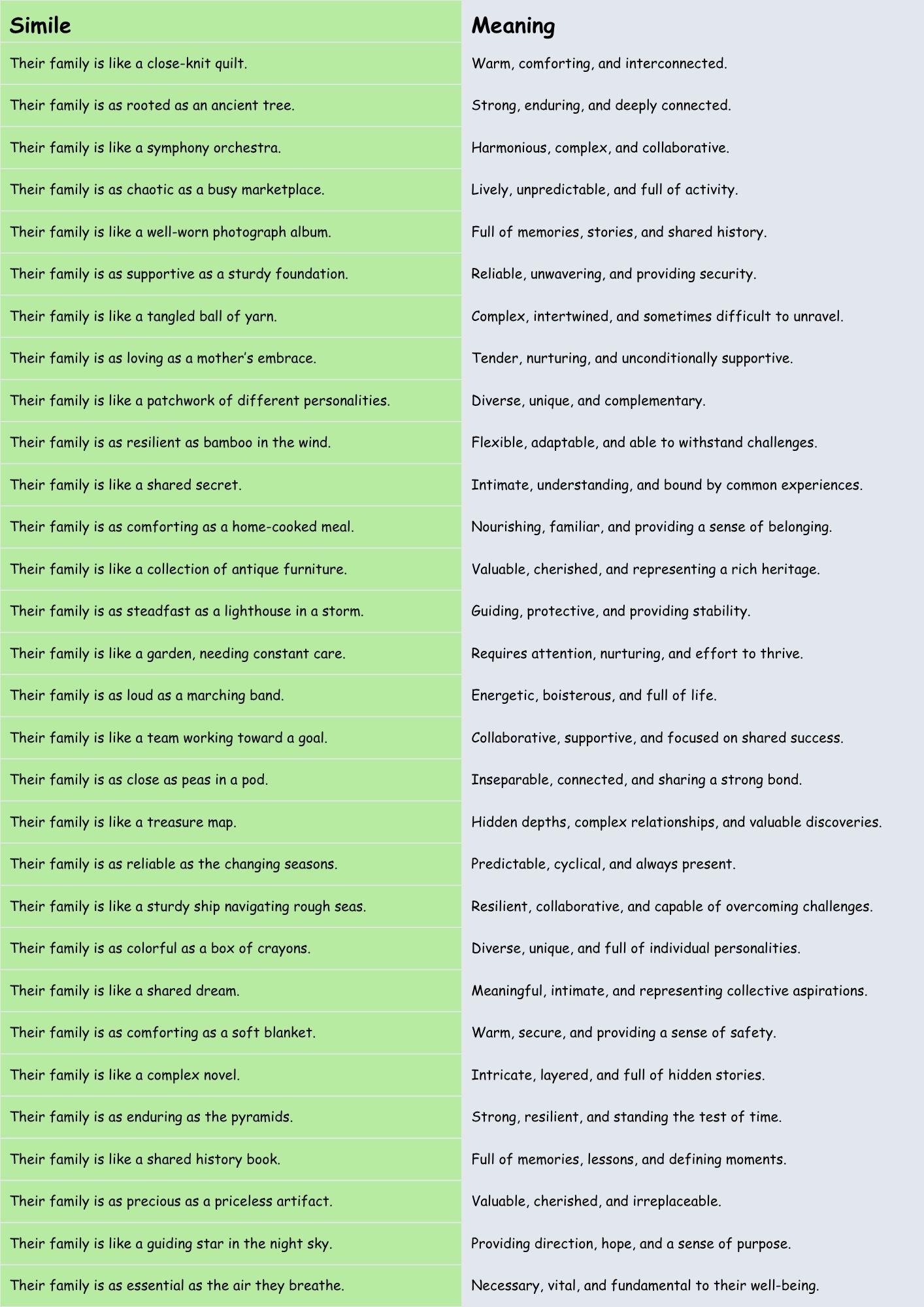
These similes can be used to describe the unique dynamics and complexities of family relationships, adding depth and emotion to your writing or conversation.
Similes for Difficult Relationships
Similes for difficult relationships highlight the tension, conflict, and challenges that can arise between people. They often use imagery that evokes feelings of discomfort, frustration, or pain.
The following table presents similes that can be used to describe challenging relationships. These similes capture the various aspects of difficult connections, from constant conflict and tension to emotional distance and communication breakdowns.
| Simile | Meaning |
|---|---|
| Their relationship is like a battlefield. | Full of conflict and constant fighting. |
| Their communication is as strained as a tightrope. | Tense, fragile, and easily broken. |
| Their connection is like a broken vase. | Damaged, irreparable, and lacking wholeness. |
| Their relationship is like walking on eggshells. | Cautious, anxious, and fearing conflict. |
| Their interactions are as cold as ice. | Distant, unfriendly, and lacking warmth. |
| Their relationship is like a thorn in one’s side. | Annoying, irritating, and causing persistent pain. |
| Their connection is as volatile as nitroglycerin. | Unstable, explosive, and prone to sudden outbursts. |
| Their relationship is like a tug-of-war. | Competitive, exhausting, and lacking cooperation. |
| Their communication is like a broken record. | Repetitive, unproductive, and frustrating. |
| Their relationship is as hollow as an empty shell. | Lacking substance, meaning, and emotional depth. |
| Their connection is like a tangled web. | Complex, confusing, and difficult to escape. |
| Their relationship is like a leaky faucet. | Dripping with negativity, resentment, and unresolved issues. |
| Their interactions are as sharp as knives. | Cutting, hurtful, and causing emotional wounds. |
| Their relationship is like a dark cloud. | Ominous, depressing, and casting a shadow over everything. |
| Their connection is as fragile as glass. | Easily broken, delicate, and requiring careful handling. |
| Their relationship is like a minefield. | Dangerous, unpredictable, and full of potential hazards. |
| Their communication is like a brick wall. | Impenetrable, resistant, and blocking understanding. |
| Their relationship is as bitter as gall. | Resentful, unpleasant, and full of animosity. |
| Their connection is like a constant storm. | Turbulent, chaotic, and lacking peace. |
| Their relationship is like a sinking ship. | Failing, deteriorating, and headed for disaster. |
| Their relationship is like a house of cards. | Unstable, easily collapsed, and lacking a strong foundation. |
| Their communication is as murky as mud. | Unclear, confusing, and lacking transparency. |
| Their relationship is as heavy as lead. | Burdensome, draining, and weighing them down. |
| Their connection is like a prison. | Confining, restrictive, and lacking freedom. |
| Their relationship is like a desert. | Barren, empty, and lacking emotional nourishment. |
| Their communication is as dry as dust. | Uninteresting, lifeless, and lacking engagement. |
| Their relationship is like a broken mirror. | Distorted, fragmented, and reflecting a flawed image. |
| Their connection is as isolating as a solitary island. | Lonely, disconnected, and lacking companionship. |
| Their relationship is like a ticking time bomb. | Tense, unpredictable, and headed for an inevitable explosion. |
| Their communication is as guarded as a fortress. | Defensive, protective, and lacking openness. |
These similes can be used to effectively convey the challenges and difficulties within relationships, providing a vivid and relatable understanding of the situation.
Similes for Professional Relationships
Similes for professional relationships often highlight the dynamics of teamwork, leadership, and collaboration in the workplace. They can also emphasize the challenges of competition, hierarchy, and communication in a professional setting.
The following table provides similes that can be used to describe professional relationships. These similes capture the nuances of workplace connections, from effective teamwork and strong leadership to communication challenges and competitive dynamics.
| Simile | Meaning |
|---|---|
| Their team is like a well-oiled machine. | Efficient, coordinated, and working seamlessly together. |
| Their leader is as steady as a ship’s captain. | Guiding, directing, and providing stability. |
| Their collaboration is like a symphony orchestra. | Harmonious, coordinated, and producing impressive results. |
| Their workplace is as competitive as a sports arena. | Driven, ambitious, and focused on achieving success. |
| Their communication is like a clear roadmap. | Direct, transparent, and easy to understand. |
| Their teamwork is as strong as a chain. | Resilient, interconnected, and able to withstand pressure. |
| Their manager is like a skilled conductor. | Orchestrating efforts, coordinating tasks, and leading effectively. |
| Their office environment is as buzzing as a beehive. | Active, productive, and full of activity. |
| Their project is like a complex puzzle. | Intricate, challenging, and requiring careful planning. |
| Their communication is as concise as a telegram. | Brief, direct, and to the point. |
| Their team is like a pit crew during a race. | Fast, efficient, and focused on quick turnaround. |
| Their mentor is as wise as an old owl. | Knowledgeable, experienced, and providing valuable guidance. |
| Their workplace is as structured as a skyscraper. | Organized, hierarchical, and built on a solid foundation. |
| Their presentation is like a captivating story. | Engaging, persuasive, and holding the audience’s attention. |
| Their communication is as filtered as a water purifier. | Carefully controlled, sanitized, and lacking transparency. |
| Their team is like a pack of wolves. | Competitive, driven, and working together to achieve goals. |
| Their supervisor is as demanding as a drill sergeant. | Strict, disciplined, and pushing for peak performance. |
| Their office is as quiet as a library. | Calm, focused, and conducive to concentration. |
| Their workload is like a mountain. | Overwhelming, challenging, and requiring significant effort. |
| Their communication is as vague as a weather forecast. | Unclear, uncertain, and lacking specific details. |
| Their team is like a sports team. | Collaborative, competitive, and working toward a common goal. |
| Their CEO is as ambitious as a rocket. | Driven, determined, and aiming for the highest achievements. |
| Their company culture is as rigid as steel. | Inflexible, resistant to change, and highly structured. |
| Their project is like a marathon. | Enduring, demanding, and requiring sustained effort. |
| Their communication is as transparent as glass. | Open, honest, and easily understood. |
| Their team is like a family. | Supportive, caring, and fostering a sense of belonging. |
| Their intern is as eager as a puppy. | Enthusiastic, willing to learn, and full of energy. |
| Their office is as colorful as a carnival. | Vibrant, energetic, and full of diverse personalities. |
| Their task is like climbing Mount Everest. | Challenging, difficult, and requiring immense effort. |
| Their communication is as convoluted as a maze. | Confusing, complex, and difficult to navigate. |
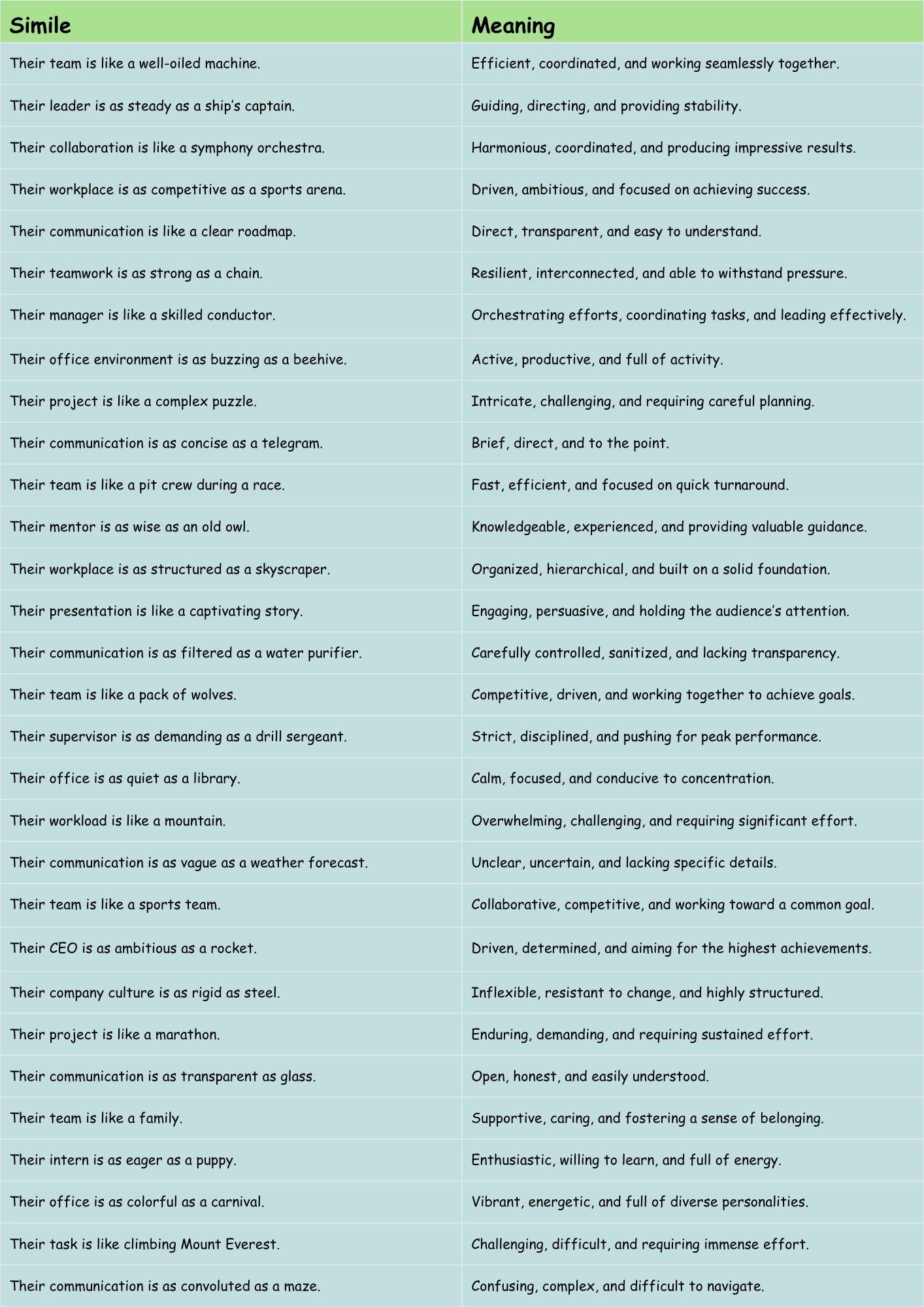
These similes can be used to describe the various dynamics and complexities of professional relationships, adding depth and clarity to your communication in the workplace.
Usage Rules for Relationship Similes
Using similes effectively requires attention to several key rules to ensure clarity, relevance, and appropriateness. These rules help to avoid misinterpretations and enhance the impact of your descriptions.
Clarity and Relevance
The most important rule is to ensure that the comparison is clear and relevant to the relationship being described. The object of the simile should be something familiar and easily understandable to the audience. The comparison should also highlight a specific quality or characteristic that is relevant to the relationship.
For example, if you say “Their love is like a complicated equation,” the audience may struggle to understand the intended meaning. A clearer and more relevant simile might be “Their love is like a warm fire,” which conveys a sense of comfort and passion.
Cultural Sensitivity
It’s important to be mindful of cultural differences and sensitivities when using similes. Some comparisons may be offensive or inappropriate in certain cultures. Avoid using similes that rely on stereotypes or that could be misinterpreted as insensitive.
For example, a simile that compares a relationship to a specific cultural practice might be misunderstood or offensive to someone from a different cultural background. Opt for more universal and neutral comparisons whenever possible.
Contextual Appropriateness
The choice of simile should be appropriate for the context in which it is being used. Consider the audience, the tone of the conversation, and the overall purpose of the communication. A simile that is suitable for a casual conversation with friends might not be appropriate for a formal presentation or a professional setting.
For example, using a highly emotional or dramatic simile in a business meeting might be perceived as unprofessional. Choose similes that are aligned with the tone and expectations of the situation.
Common Mistakes When Using Relationship Similes
Several common mistakes can undermine the effectiveness of relationship similes. Being aware of these pitfalls can help you avoid them and use similes more skillfully.
One common mistake is using clichéd similes. Overused similes, such as “Their love is like a rose,” have lost their impact and can make your writing or speech sound unoriginal. Strive to create fresh and imaginative comparisons that capture the unique aspects of the relationship.
Another mistake is using inconsistent comparisons. Make sure that the object of the simile aligns logically with the subject and conveys the intended meaning. Avoid comparisons that are confusing or contradictory. For instance, saying “Their relationship is like a sunny day, but also full of thunderstorms” creates a mixed message.
A further error is using overly complex or abstract similes. The purpose of a simile is to clarify and enhance understanding, not to confuse the audience. Choose comparisons that are easily grasped and that add depth to the description.
Here are some examples of common mistakes and their corrections:
| Incorrect Simile | Corrected Simile | Explanation |
|---|---|---|
| Their love is like a rose. | Their love is like a blooming garden. | The corrected simile is more vivid and less clichéd. |
| Their relationship is like a sunny day, but also full of thunderstorms. | Their relationship is like a rollercoaster. | The corrected simile provides a more consistent and understandable comparison. |
| Their friendship is like quantum physics. | Their friendship is like a shared adventure. | The corrected simile is more accessible and relatable. |
Practice Exercises
To reinforce your understanding of relationship similes, complete the following exercises. Each exercise presents a scenario or description, and your task is to create an appropriate simile to capture the essence of the relationship.
Exercise 1: Fill in the Blanks
Complete the following sentences by adding a simile that accurately describes the relationship.
| Question | Answer |
|---|---|
| Their friendship is | ____________________________________________________. |
| Their love is ____________________________________________________. | |
| Their family is ____________________________________________________. | |
| Their professional relationship is __________________________________. | |
| Their difficult relationship is ____________________________________. |
Exercise 2: Simile Creation
Create a simile for each of the following relationship scenarios:
- A couple who have been together for 50 years and still deeply in love.
- Two colleagues who are constantly competing with each other.
- A family that always supports each other through thick and thin.
- A friendship that has survived many challenges and hardships.
- A romantic relationship that is full of passion and excitement.
Exercise 3: Simile Analysis
Analyze the following similes and explain what they convey about the relationship:
- “Their love is like a gentle stream.”
- “Their relationship is as turbulent as a stormy sea.”
- “Their friendship is like a sturdy bridge.”
- “Their family is as close-knit as a quilt.”
- “Their professional relationship is like a chess game.”
Advanced Topics: Metaphors vs. Similes
While similes use “like” or “as” to make comparisons, metaphors directly equate two unlike things without using these words. Understanding the difference between metaphors and similes can enhance your ability to use figurative language effectively.
A simile states that something is like something else, while a metaphor asserts that something is something else. For example:
- Simile: “Their love is like a warm fire.” (Comparing love to a fire)
- Metaphor: “Their love is a warm fire.” (Equating love to a fire)
Metaphors can be more powerful and direct than similes, but they also require a deeper understanding of the implied comparison. When choosing between a simile and a metaphor, consider the level of subtlety and impact you want to achieve.
Here’s a table illustrating the difference between similes and metaphors in the context of relationships:
| Relationship Description | Simile | Metaphor |
|---|---|---|
| A strong friendship | Their friendship is like a sturdy oak tree. | Their friendship is a sturdy oak tree. |
| A difficult relationship | Their relationship is like a battlefield. | Their relationship is a battlefield. |
| A loving family | Their family is as close-knit as a quilt. | Their family is a close-knit quilt. |
By mastering both similes and metaphors, you can add depth, nuance, and creativity to your descriptions of relationships.
Frequently Asked Questions
- Q: What is the difference between a simile and a metaphor?
- A: A simile compares two things using “like” or “as,” while a metaphor directly equates two things without using these words.
- Q: How can I avoid using clichéd similes?
- A: Strive to create fresh and imaginative comparisons that capture the unique aspects of the relationship. Avoid overused phrases and seek inspiration from diverse sources.
- Q: Is it okay to use negative similes to describe relationships?
- A: Yes, but be mindful of the context and audience. Negative similes can be effective for conveying challenges and difficulties, but use them with sensitivity and tact.
- Q: How can I ensure that my similes are clear and relevant?
- A: Choose objects of comparison that are familiar and easily understandable to your audience. Make sure the comparison highlights a specific quality or characteristic that is relevant to the relationship.
- Q: Can similes be used in professional settings?
- A: Yes, but use them judiciously and choose comparisons that are appropriate for the tone and expectations of the situation. Avoid overly emotional or dramatic similes.
Conclusion
Similes provide a powerful and versatile tool for describing relationships in vivid and meaningful ways. By understanding the structure, types, and usage rules of similes, you can effectively convey the nuances and complexities of human connections. Whether you’re writing a novel, giving a speech, or simply trying to communicate more effectively in your personal life, mastering the art of relationship similes will enhance your ability to express yourself with clarity, creativity, and impact. Remember to be mindful of clarity, cultural sensitivity, and contextual appropriateness to ensure that your similes resonate with your audience and convey your intended meaning effectively.

